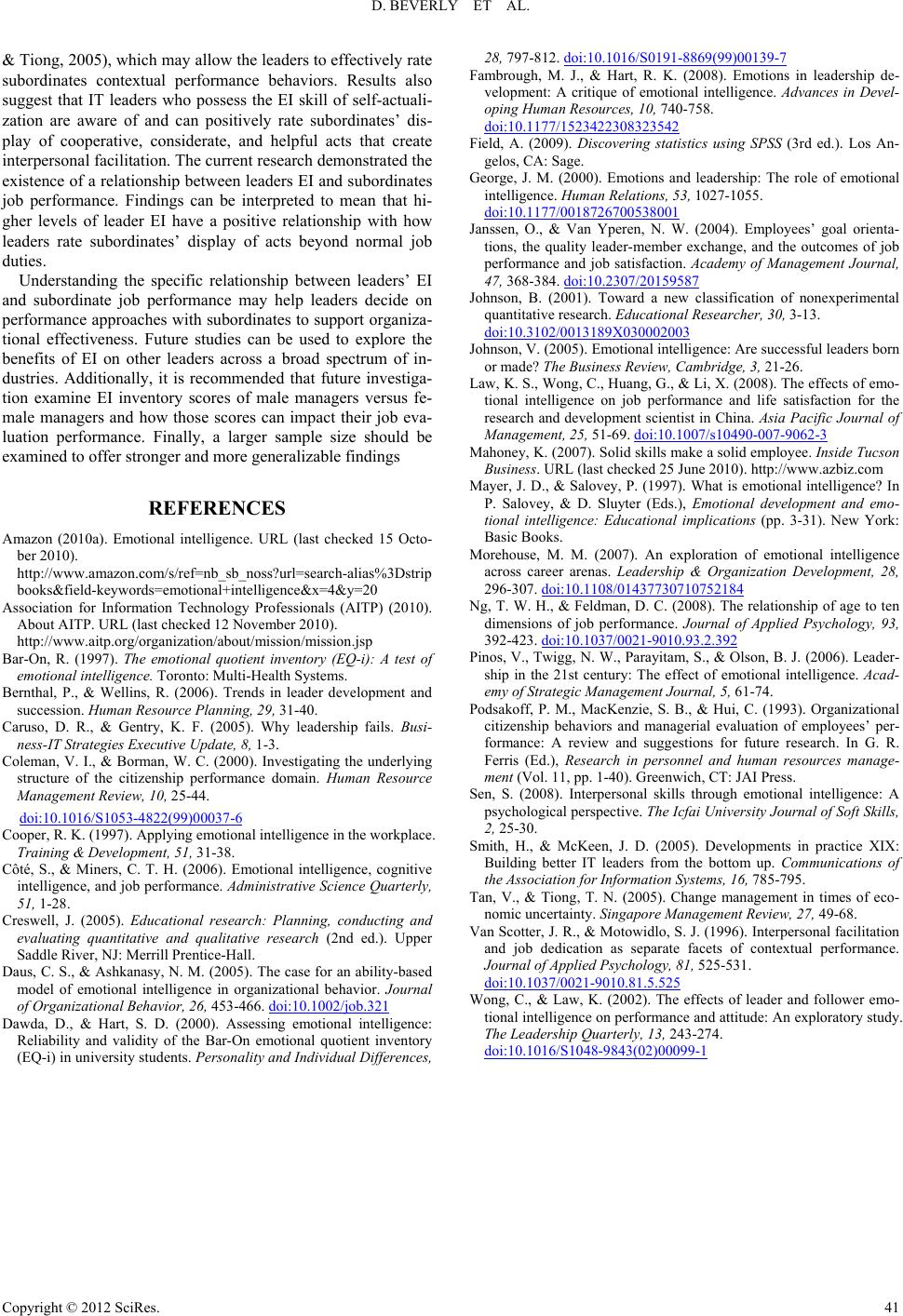
D. BEVERLY ET AL.
& Tiong, 2005), which may allow the leaders to effectively rate
subordinates contextual performance behaviors. Results also
suggest that IT leaders who possess the EI skill of self-actuali-
zation are aware of and can positively rate subordinates’ dis-
play of cooperative, considerate, and helpful acts that create
interpersonal facilitation. The current research demonstrated the
existence of a relationship between leaders EI and subordinates
job performance. Findings can be interpreted to mean that hi-
gher levels of leader EI have a positive relationship with how
leaders rate subordinates’ display of acts beyond normal job
duties.
Understanding the specific relationship between leaders’ EI
and subordinate job performance may help leaders decide on
performance approaches with subordinates to support organiza-
tional effectiveness. Future studies can be used to explore the
benefits of EI on other leaders across a broad spectrum of in-
dustries. Additionally, it is recommended that future investiga-
tion examine EI inventory scores of male managers versus fe-
male managers and how those scores can impact their job eva-
luation performance. Finally, a larger sample size should be
examined to offer stronger and more generalizable findings
REFERENCES
Amazon (2010a). Emotional intelligence. URL (last checked 15 Octo-
ber 2010).
http://www.amazon.com/s/ref=nb_sb_noss?url=search-alias%3Dstrip
books&field-keywords=emotional+intelligence&x=4&y=20
Association for Information Technology Professionals (AITP) (2010).
About AITP. URL (last checked 12 November 2010).
http://www.aitp.org/organization/about/mission/mission.jsp
Bar-On, R. (1997). The emotional quotient inventory (EQ-i): A test of
emotional intelligence. Toronto: Multi-Health Systems.
Bernthal, P., & Wellins, R. (2006). Trends in leader development and
succession. Human Resource Plan ning , 29, 31-40.
Caruso, D. R., & Gentry, K. F. (2005). Why leadership fails. Busi-
ness-IT Strategies Executive Update, 8, 1-3.
Coleman, V. I., & Borman, W. C. (2000). Investigating the underlying
structure of the citizenship performance domain. Human Resource
Management Review, 10, 25-44.
doi:10.1016/S1053-4822(99)00037-6
Cooper, R. K. (1997). Applying emotional intelligence in the workplace.
Training & Development, 51, 31-38.
Côté, S., & Miners, C. T. H. (2006). Emotional intelligence, cognitive
intelligence, and job performance. Administrative Science Quarterly,
51, 1-28.
Creswell, J. (2005). Educational research: Planning, conducting and
evaluating quantitative and qualitative research (2nd ed.). Upper
Saddle River, NJ: Merrill Prentice-Hall.
Daus, C. S., & Ashkanasy, N. M. (2005). The case for an ability-based
model of emotional intelligence in organizational behavior. Journal
of Organizational Behavior, 26, 453-466. doi:10.1002/job.321
Dawda, D., & Hart, S. D. (2000). Assessing emotional intelligence:
Reliability and validity of the Bar-On emotional quotient inventory
(EQ-i) in university students. Personality and Individual Differences,
28, 797-812. doi:10.1016/S0191-8869(99)00139-7
Fambrough, M. J., & Hart, R. K. (2008). Emotions in leadership de-
velopment: A critique of emotional intelligence. Advances in Devel-
oping Human Resources, 10, 740-758.
doi:10.1177/1523422308323542
Field, A. (2009). Discovering statistics using SPSS (3rd ed.). Los An-
gelos, CA: Sage.
George, J. M. (2000). Emotions and leadership: The role of emotional
intelligence. Human Re la tio ns, 53, 1027-1055.
doi:10.1177/0018726700538001
Janssen, O., & Van Yperen, N. W. (2004). Employees’ goal orienta-
tions, the quality leader-member exchange, and the outcomes of job
performance and job satisfaction. Academy of Management Journal,
47, 368-384. doi:10.2307/20159587
Johnson, B. (2001). Toward a new classification of nonexperimental
quantitative research. Educa t io na l Researcher, 30, 3-13.
doi:10.3102/0013189X030002003
Johnson, V. (2005). Emotional intelligence: Are successful leaders born
or made? The Busines s R e v ie w , Cambr i d ge , 3, 21-26.
Law, K. S., Wong, C., Huang, G., & Li, X. (2008). The effects of emo-
tional intelligence on job performance and life satisfaction for the
research and development scientist in China. Asia Pacific Journal of
Management, 25, 51-69. doi:10.1007/s10490-007-9062-3
Mahoney, K. (2007). Solid skills make a solid employee. Inside Tucson
Business. URL (last checked 25 June 2010). http://www.azbiz.com
Mayer, J. D., & Salovey, P. (1997). What is emotional intelligence? In
P. Salovey, & D. Sluyter (Eds.), Emotional development and emo-
tional intelligence: Educational implications (pp. 3-31). New York:
Basic Books.
Morehouse, M. M. (2007). An exploration of emotional intelligence
across career arenas. Leadership & Organization Development, 28,
296-307. doi:10.1108/01437730710752184
Ng, T. W. H., & Feldman, D. C. (2008). The relationship of age to ten
dimensions of job performance. Journal of Applied Psychology, 93,
392-423. doi:10.1037/0021-9010.93.2.392
Pinos, V., Twigg, N. W., Parayitam, S., & Olson, B. J. (2006). Leader-
ship in the 21st century: The effect of emotional intelligence. Acad-
emy of Strategic Management Journal, 5, 61-74.
Podsakoff, P. M., MacKenzie, S. B., & Hui, C. (1993). Organizational
citizenship behaviors and managerial evaluation of employees’ per-
formance: A review and suggestions for future research. In G. R.
Ferris (Ed.), Research in personnel and human resources manage-
ment (Vol. 11, pp. 1-40). Greenwich, CT: JAI Press.
Sen, S. (2008). Interpersonal skills through emotional intelligence: A
psychological perspective. The Icfai University Journal of Soft Skills,
2, 25-30.
Smith, H., & McKeen, J. D. (2005). Developments in practice XIX:
Building better IT leaders from the bottom up. Communications of
the Association for Information Systems, 16, 785-795.
Tan, V., & Tiong, T. N. (2005). Change management in times of eco-
nomic uncertainty. Singapore Management Review, 2 7, 49-68.
Van Scotter, J. R., & Motowidlo, S. J. (1996). Interpersonal facilitation
and job dedication as separate facets of contextual performance.
Journal of Applied Psy ch o l og y , 81, 525-531.
doi:10.1037/0021-9010.81.5.525
Wong, C., & Law, K. (2002). The effects of leader and follower emo-
tional intelligence on performance and attitude: An exploratory study.
The Leadership Quarterly, 13, 243-274.
doi:10.1016/S1048-9843(02)00099-1
Copyright © 2012 SciRes. 41